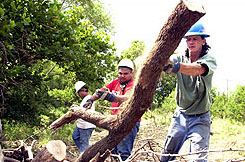|
| |

August
15, 2003

The Natural Resources Conservation
Service provides leadership in a partnership effort to help people conserve,
maintain, and improve our natural resources and environment.
NRCS conservationists Graylen Hall, right, and Tracy
Sexton, center, work with a landowner in Vienna, Georgia, to install a
conservation plan for his farm. Image: Dot Paul.
In this Issue
Focus on the Field
NRCS Cleans Up
Flood-damaged Creeks in Texas
NRCS Program Supports Purchase of Virginia Landmark
Oregon's Siuslaw River Project One of Five International
Finalists
Loup RC&D Gets National Recognition
Snake River Project Launched
Word from Washington
USDA Signs Memoranda of
Understanding to Restore Quail Habitat in the Southeast
NRCS Legislative Summaries, Testimony,
and Reports
Tech Tip
SPAW Version 6.1 Water Budget
Model Released
Links to USDA and NRCS Drought News and Assistance
Defending
Against Drought
NRCS Colorado Drought Information
USDA Disaster Assistance Web Site
National Drought Monitor Web Site
Upcoming Events
Major conferences and exhibitions of interest to NRCS and its partners are
happening all across the Nation. Click here
to find an event near you.
NRCS This Week Information and Contacts
Subscribe to NRCS This Week
NRCS This Week Index and Archives
Contact Us
Discover NRCS!
Focus on the Field
 NRCS
Cleans Up Flood-damaged Creeks in Texas NRCS
Cleans Up Flood-damaged Creeks in Texas
NRCS is picking up three-quarters of the cost of a $1.2 million effort to
restore Leon and Salado creeks near San Antonio, Texas. The creeks, both vital
components of San Antonio’s water system, were devastated by floods last year.
Toppled trees and abandoned appliances have created impasses in the creek beds
and along the banks that could end up causing future flooding problems.
Clearing the debris without inflicting further damage to the fragile creeks is a
challenge.
"There's a lot of accumulated debris," contractor Dave Coones said. "If by going
into a pile I'm going to hurt it worse than I help it — I stay out."
Removing dead trees and large chunks of mangled metal is more challenging when
it takes place in a muddy creek bottom or along a shady bank, said Richard
Martinez, the city's drainage superintendent. "We've got to be real careful.
This is a riparian area," said Martinez.
Dead, downed, and leaning trees found in the bottom of the creekbed or on the
banks will be converted into mulch on site.
Invasive species will be targeted for removal, while most live oak and pecan
trees will be spared.
Tim Buscha, Emergency
Watershed Protection program manager for NRCS in Temple,
said the work would not prevent major floods like those that occurred in 1998
and 2002. Buscha said the debris being removed will help keep smaller events
from causing bigger problems.
"If you're going to get the debris out, there's not a better way to do it," he
said. (San Antonio Express-News. Image: Local cooperators Richard Watts (right),
Jeffrey Wittman (center), and Jesse Trevino clean up flood debris along Leon
Creek.)
NRCS Program Supports Purchase of Virginia Landmark
NRCS is helping a local partnership preserve a 144-acre farm on the edge of
Virginia’s Waterford National Historic Landmark district.
The push to preserve
the Phillips Farm moved into a new phase this week after the nonprofit Trust
for Public Land secured a contract to purchase the property for $3.9 million.
NRCS is providing $800,000 for the purchase through the Farm and Ranch Land
Protection Program. The coalition already has $2.2 million in grants, pledges,
and cash.
Even as negotiations reached the end late last week, the property owner was
entertaining purchase offers from others hoping to build luxury estates on the
ridgetop land overlooking the village.
The landmark was designated by the Department of the Interior in 1970 because
the setting of a Quaker village remains largely as it was more than a century
ago.
The Phillips Farm property was down-zoned by the county government in January.
However, county supervisors did not expand the boundaries of the Waterford
Historic District to include the property. That action would have given the
county more control over development on the farm. Plans submitted for county
review called for 14 homes to be built on the property.
(Leesburg Today)
 Oregon's
Siuslaw River Project One of Five International Finalists Oregon's
Siuslaw River Project One of Five International Finalists
The Thiess International Riverprize nominating committee has selected Oregon's
Siuslaw River Basin Restoration project as one of five worldwide to
compete as a finalist for the prestigious Riverprize in Australia in September.
The Siuslaw Soil and Water Conservation District is a partner in the project.
The $100,000 Thiess Riverprize recognizes excellence in river management. Three
specific project areas within the basin highlighted in the nomination include
Knowles Creek, a 15-year stream restoration project; Deadwood Creek Enhancement,
implementing restoration on private land; and Karnowsky Creek, an entire
1,800-acre watershed restoration project that includes a state-of-the-art stream
restoration project.
The Siuslaw River Basin Project competed against 15 nominations worldwide, including the
Danube River in Eastern Europe, the Alexander River in Israel and Palestine, and
the Arvari River in India. A winner will be selected in early September
2003.
Over the past 2 years, restoration projects in the basin have generated between
$2.5 million and $3.7 million each year for the local economy through jobs and
related expenditures. (Coos Bay World. Image: A section of the Siuslaw Basin Restoration Project. World File Photo)
Loup RC&D Gets National Recognition
Central Nebraska's Loup Basin Resource
Conservation and Development (RC&D) Council has been named winner of the Natural
Resource Conservation Service/RC&D 2002 National Earth Team Award. The
announcement was made recently during the National RC&D Association Conference
in San Antonio, Texas.
In a news release, the RC&D's leadership said the efforts of many volunteers
within the nine-county area served by the Loup Basin RC&D have made the council
a success. The council serves Blaine, Loup, Custer, Garfield, Wheeler, Valley,
Greeley, Sherman and Howard counties.
In fiscal year 2002, the Loup Basin RC&D recorded 40 volunteers and volunteer
groups, which together served more than 4,000 hours. The efforts of the volunteers ranged
from assisting with meetings and conferences to volunteering at booths, fairs,
and festivals.
The Loup Basin RC&D Council consists of several committees that focus on
concerns in Central Nebraska. Those committees include the Tourism Committee,
Economic Development Committee, water association, and Loup Rivers Scenic Byway
Committee. (Grand Island Independent)
Snake River Project Launched
Wyoming’s Teton Conservation
District has signed an agreement with the Army Corps of Engineers and Teton
County officials launching a $52.2 million restoration project along the Snake
River. The project, to be carried out over 50 years, will protect and enhance
habitat along more than 20 miles of the river near Jackson to repair damage
caused by levees that constrict the river's flow.
The multi-stage project, which extends from Grand Teton National Park into South Park,
should help repair some of the damage from the levee system. Crews will build a
series of structures along the riverbanks and in front of islands to slow the
current. Some river channels will be deepened to divert currents, and officials
hope after time to rejuvenate wetlands currently outside the levee system. They
also hope trees will grow on the islands formed from the sediment.
The river's habitat has been degraded over the years as currents quickened and
islands washed away, blocking streams for cutthroat trout and depriving wetlands
of their lifeblood. Historically, the river floods nearby land every spring.
The restoration will be a slow, ongoing process. "Doing it at a slower rate will
allow us to learn how the river reacts," a Teton County official said. "If the
river reacts negatively to the placement of a feature or to the feature itself,
then you don't put a whole bunch more features like it out there."
(Casper Star-Tribune)
Word from Washington
 USDA
Signs Memoranda of Understanding to Restore Quail Habitat in the Southeast USDA
Signs Memoranda of Understanding to Restore Quail Habitat in the Southeast
On August 7, NRCS Chief Bruce Knight signed three Memoranda of Understanding (MOUs)
to restore northern bobwhite quail on private working lands across the
Southeast. A representative for the Southeastern Association of Fish and
Wildlife Agencies in Tallahassee, Fla., South Carolina-based
Quail Unlimited,
Inc., and Mississippi State University (MSU), each signed a separate MOU at a
ceremony at MSU. These MOUs establish a framework of cooperation among the
partners to evaluate the Northern Bobwhite Quail Conservation Initiative.
The signing ceremonies took place in Starkville, Mississippi.
NRCS Legislative Summaries, Testimony,
and Reports
Click here for timely and accurate information from NRCS Legislative
Affairs.
Tech Tip
SPAW Version 6.1 Water Budget Model Released
Version 6.1 of the Soil-Plant-Air-Water (SPAW) water budget model is now
available from the National Water and Climate Center (NWCC). SPAW Version 6.1 is
common computing environment (CCE) compliant for both Microsoft Windows ® XP and
NT operating systems.
SPAW is a field-level tool that uses a modified Soil Conservation Service Curve
Number Method to develop water budgets for agricultural fields. Water budget
processes are evaluated by making daily adjustments to crop canopy cover and
antecedent soil moisture. Daily, monthly, and annual water budgets are presented
in table and graph format. Field water budgets can be used by field staff for
evaluating runoff and infiltration from precipitation events.
SPAW also provides an integrated pond module to develop pond water budgets. The
primary inflows to the pond are surface runoff and precipitation. Auxiliary
inflows, such as well and stream diversions or dairy wash water, allow budgets
to represent processes for storage reservoirs as well as waste lagoons. Pond
areas can also represent inundated wetland areas. A statistical evaluation
provides an analysis of inundation frequency. Pumping simulations to replicate
managed inflow/outflow can be set for automatic or manual activation. Tabular
and graphical outputs provide daily, monthly, and annual summaries for the major
water budget processes.
The SPAW model is a product of the Agricultural Research Service and NRCS. The
SPAW download is available from either the NWCC Web site at
http://www.wcc.nrcs.usda.gov/wetdrain/wetdrain-tools.html, or from the USDA
Service Center for CCE software at
http://servicecenter.kcc.usda.gov/.
 Discover
NRCS! Discover
NRCS!
The people of NRCS, along with the agency’s partners,
help owners of America’s private lands conserve soil, water, and other
natural resources. NRCS is known worldwide for its accomplishments and
innovations in conserving soil, protecting wildlife, improving water
quality, restoring wetlands, preserving farmland, enhancing grasslands, and
taking other actions to keep natural resources productive and
plentiful.
Click here to learn more about the Natural Resources Conservation Service!
Subscribe to NRCS This Week!
You can receive NRCSTW via e-mail by sending an e-mail to:
listproc@nrcs.usda.gov. Do not use a
subject line and put the following in the body of the message: subscribe
NRCS-THIS-WEEK Firstname Lastname (example: subscribe NRCS-THIS-WEEK Robin
Jones). Help with other commands that are available at the
“listproc@nrcs.usda.gov” address, send a message with no subject and the word
HELP on a line by itself in the body of the message. “NRCS This Week” is posted
on the NRCS Homepage.
Contact Us
Please end correspondence and material for "NRCS This Week" to the editor by: e-mail to:
fred.jacobs@usda.gov or by fax to: Editor, "NRCS This Week," 202-720-1564; or by mail to: Editor, "NRCS This Week," NRCS, P.O. Box 2890, Washington, D.C. 20013.
The U.S. Department of Agriculture (USDA) prohibits discrimination in all its programs and activities on the basis of race, color, national origin, sex, religion, age, disability, political beliefs, sexual orientation, or marital or family status. (Not all prohibited bases apply to all programs.) Persons with disabilities who require alternative means for communication of program information (Braille, large print, audiotape, etc.) should contact USDA's TARGET Center at 202-720-2600 (voice and TDD).
To file a complaint of discrimination, write USDA, Director, Office of Civil Rights, Room 326W, Whitten Building, 14th and Independence Avenue, SW, Washington, D.C. 20250-9410 or call 202-720-5964 (voice and TDD). USDA is an equal opportunity provider and employer.
| | |
